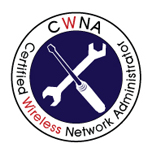 CWNA Course
CWNA Course
Enterprise Wi-Fi Administration, Outline v7.0 – Official course for the CWNA-107 Certification Exam
Click here to register for this course
CWNA Introduction
The CWNA – Enterprise Wireless LAN Administration course, whether in an academic format or a 4-day fast-track format, provides the networking professional a complete foundation of knowledge for entering into or advancing in the wireless networking industry. From basic RF theory to 802.11 frame exchange processes, this course delivers hands-on training that will benefit the novice as well as the experienced network professional.
Upcoming classes:
Melbourne:
See Schedule
Sydney:
See Schedule
 Associated Certifications: CWNA – Certified Wireless Network Administrator
Associated Certifications: CWNA – Certified Wireless Network Administrator- Price: $3,250.00 (ex)
- Duration: 4 days, Classroom
- Delivery Options : 4 day fast track or 1 day per week over 4 weeks
- Availability: Sydney, Melbourne, Brisbane and Canberra. Perth coming in Q2 2018
- Prerequisites: Basic networking knowledge, including OSI model and IP subnetting
CWNA Course Outline
The following list contains the official materials covered in the lecture portion of the course.
Introduction to WLAN Standards
- Introduction to WLAN industry organisations
- Discuss protocol standards and compliance
- Overview of 802.11 standard and amendments
- Discuss additional networking standards that are commonly used to enhance WLANs
- Regulatory domains and their impact
Radio Frequency (RF) Fundamentals
- RF propagation
- Properties of RF waves
- Types of power loss and environmental impact on radio waves
- Spread spectrum, modulation and coding
- Channels and bandwidth
Antennas
- Antenna fundamentals
- Polarisation and gain
- Types of WLAN antennas
- Antenna systems
- Antenna implementation and safety
- RF cables, connectors, and accessories
RF Math
- RF units of measure
- Basic RF math
- RF signal measurements
- Link budgets
Regulatory Domains
- Regulatory domains
- Regulatory bodies and frequency bands
- Output power rules and examples
WLAN Operation
- Basic WLAN hardware
- Basic operating modes
- WLAN hardware continued
- WLAN connectivity
- WLAN architecture
- Wireless Network Management System (WNMS)
Power over Ethernet
- PoE device types
- Power delivery
- Planning for POE
- PoE standards
802.11 Service Sets
- Service set types
- Authentication and association
- Network infrastructure
- Roaming within a WLAN
- Load balancing
Basic WLAN Analysis
- Protocol Analysis
- 802.11 Frame Types
- Protection mechanism
- Power saving operations
- Transmission rates
Coordinating Frame Transmissions
- Introducing CSMA/CA
- Distributed Coordination Function (DCF)
- Quality of Service (QoS)
Modern 802.11 PHYs
- HT (802.11n) PHY and MAC layer enhancements
- MIMO and SISO systems
- HT coexistence mechanisms
- HT integration and deployment
- HT site surveying and analysis
- VHT (802.11ac) PHY and MAC layer enhancements
Wireless Site Survey Fundamentals
- RF site survey defined
- Gathering information and resources
- Spectrum analysis for site surveys
- Site survey types
- Survey considerations
- Survey deliverables
Basic WLAN Security
- The importance of WLAN security
- Security policy
- Legacy WLAN security mechanisms
- Modern WLAN security mechanisms
- Baseline WLAN security practices
Modern Challenges (BYOD and Guest Access)
- Mobile Device Management (MDM)
- Bring Your Own Device (BYOD)
- Guest access
- High density wireless basics
Potential Hands-on Lab Exercises
Exploring 802.11
- Understanding standard documents
- Viewing the various sections
- Mastering the terminology
2.4 GHz vs. 5 GHz Congestion
- Viewing activity in a spectrum analyzer
- Viewing active networks in a Wi-Fi Finder (inSSIDer)
Antennas
- Changing antenna’s for different results
Viewing RSSI
- RSSI values of different adapters at the same location
2.4 GHz Amplified
- The impact of amplifiers vs. antenna gain
Configuring APs
- Configuring and autonomous AP
- Configuring a lightweight AP
Configuring Clients
- Configuring connection profiles
- Configuring security
Protocol Analysis
- Capturing frames
- Analyzing frames
Spectrum Analysis
- Viewing activity
- Understanding signatures
RTS/CTS Impact
- Protection mechanism configuration
- Performance comparisons
802.11n/ac Impact
- Spectrum view with an 802.11n/ac AP
- Spectrum view with an 802.11a/g AP
Site Survey
Two specific classes of site survey methodology exist and are used in the WLAN market today. This exercise is separated into two sections identifying each methodology:
- Section A: Manual site surveys (sometimes called the walkabout)
- Section B: Predictive analysis (sometimes called automated site surveying)
Within each class exist two distinct categories. Manual site surveying can be categorized as active mode or passive mode, one or both modes can be used at any given time.
Predictive analysis software tools are based on a mathematical model of a facility blueprint and can be performed in two distinct ways. First, importing an AutoCAD (vector graphic) drawing allows the predictive analysis software tool to understand detailed complex layers of a facility’s construction, including wall attenuation, attenuation between floors, and channel interference. Second, importing of raster graphics, such as .jpg or .bmp, allows for faster but often less accurate modeling.
Neither methodology is 100% accurate, since each has its own individual weaknesses. Used together, the surveyor can create a more complete RF snapshot of any facility.
In this exercise, students will conduct both manual and predictive analysis surveying, using software and hardware tools (determined by the instructor or specific class needs).
Basic WLAN Security
- Viewing packets without security
- Configuring an AP to use WPA2-Personal
- Connecting to the AP with a client
- Viewing packet with security
